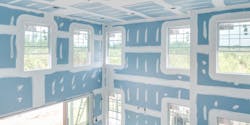3 Tips For Home Mold Prevention
Mold is an ongoing threat to a home’s indoor air quality and a family’s respiratory health. Mold needs four things to grow: oxygen, moisture, food (often the cellulose found in wood and paper) and a temperature between 41° F and 104° F. Whenever water is trapped behind walls or paneling, the potential for mold growth is strong.
Below are three important tips that builders can use to help control moisture in order for the homeowner to maintain a healthy, mold-free home:
- Assemble a strong defense from the outside in: It’s easiest to field a strong defense against mold-causing moisture infiltration when it comes to the exterior of a home. For instance, behind the siding, a complete water resistive barrier (WRB) system should be employed. These include the house wrap and all accessories such as tapes and seals intended to create closure. Together, they provide a water- and wind-tight, well ventilated building envelope on a home’s exterior.
- As the home’s roof is the first line of defense against the majority of rainfall, it’s a good place for a “belt and suspenders” approach: There are particular roofing systems available that are specifically designed to provide optimum protection from the elements. Shingles are manufactured with special adhesive strips that prevent shingle lift and the infiltration of wind-driven rain. In critical areas of higher wind speeds, such as at the exposed edge of a dormer, additional sealant can be applied to ensure long term durability. Beneath the shingles should be a high-quality underlayment such as Diamond Deck, which provides additional protection against leaks or excessive water flow in the roof’s most vulnerable areas. System ventilation products will also circulate fresh air through the attic space to prevent moisture from becoming trapped beneath the roof and they help the roof to “breath” from the underside.
- Reduce existing interior air pollutants with innovative drywall and insulation solutions: Installing AirRenew M2Tech Indoor Air Quality drywall from CertainTeed can give homeowners peace of mind. In addition to providing enhanced moisture and mold resistance, it also absorbs formaldehyde, one of the most common airborne volatile organic compounds (VOCs), often introduced through the off gassing of new furniture, paint, carpeting and fresheners; and converts it into a safe, inert compound that is trapped inside the board. Insulation that features an integrated smart vapor retarder, such as SMARTBATT, blocks indoor moisture from entering when humidity in the wall cavity is low and breathes when it senses high humidity that needs to be released—reducing the potential for mold and mildew growth.
By specifying materials designed to control moisture, a builder can greatly improve the confidence of the homeowner. But there may be instances where moisture and mold occur after the homeowner takes residence. Sharing a few references to learn more about controlling mold and moisture in the home can go a long way toward helping your homeowner take control, such as FEMA's mold factsheet.
For more information about mold prevention, visit epa.gov/mold and to learn about CertainTeed building products, such as AirRenew drywall, please visit CertainTeed.com/AirRenew.

